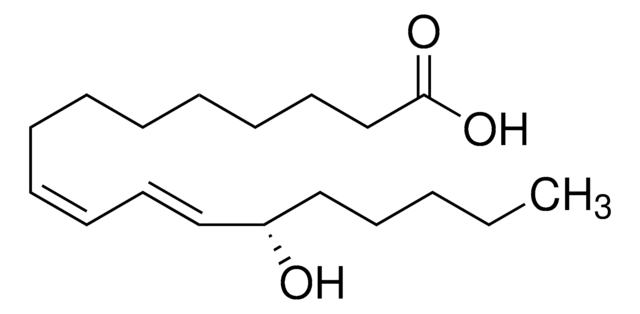SML0503
9(S)-HODE
≥98% (HPLC)
Synonym(s):
9S-Hydroxy-10E,12Z-octadecadienoic acid
About This Item
Recommended Products
Quality Level
Assay
≥98% (HPLC)
form
solution
concentration
1 mg/mL in ethanol
color
colorless to light yellow
shipped in
wet ice
storage temp.
−20°C
SMILES string
CCCCC/C=C\C=C\[C@@H](O)CCCCCCCC(O)=O
InChI
1S/C18H32O3/c1-2-3-4-5-6-8-11-14-17(19)15-12-9-7-10-13-16-18(20)21/h6,8,11,14,17,19H,2-5,7,9-10,12-13,15-16H2,1H3,(H,20,21)/b8-6-,14-11+/t17-/m1/s1
InChI key
NPDSHTNEKLQQIJ-UINYOVNOSA-N
Biochem/physiol Actions
Signal Word
Danger
Hazard Statements
Precautionary Statements
Hazard Classifications
Eye Irrit. 2 - Flam. Liq. 2
Storage Class Code
3 - Flammable liquids
WGK
WGK 1
Flash Point(F)
57.2 °F - closed cup
Flash Point(C)
14.0 °C - closed cup
Certificates of Analysis (COA)
Search for Certificates of Analysis (COA) by entering the products Lot/Batch Number. Lot and Batch Numbers can be found on a product’s label following the words ‘Lot’ or ‘Batch’.
Already Own This Product?
Find documentation for the products that you have recently purchased in the Document Library.
Our team of scientists has experience in all areas of research including Life Science, Material Science, Chemical Synthesis, Chromatography, Analytical and many others.
Contact Technical Service








